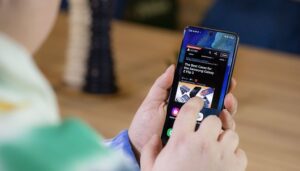OneUI is one of the most famous Android skins in the smartphone market. The latest version, OneUI 4, brings some new features to the latest Samsung smartphones. Using this guide, discover the most useful OneUI features such as keeping track of your screen time as well as other hidden features that will help you use your Samsung Galaxy smartphone or tablet like a boss.
This article lists the best features of Samsung’s OneUI. You can find our comprehensive OneUI 4 review, the latest version of Samsung’s mobile OS based on Android 12. If you have an older Samsung smartphone that runs on OneUI 3 or OneUI 3.1, this article remains relevant and you can still check if and when your Samsung smartphone will receive the Android 12 update.
Jump to:
View the screen time of your Samsung smartphone
Enable Find My Mobile if you lose your Samsung smartphone
Customize the Material You theme for OneUI
Switch from Samsung Free to Google Discover on the home screen
Change the icon layout on your Samsung home screen
Adding widgets to the lock screen in OneUI
Hide or unhide an application in OneUi
Use the Wireless Powershare feature of your Samsung smartphone
Customize the Side Panel menu in OneUI
Enable dual messenger to use two WhatsApp accounts
Disable (or reassign) the Bixby or power button
Share your WiFi easily
Open an application in split screen or floating windows
Save a screenshot on your Samsung smartphone
Enable gesture navigation
Customize Dark Mode
Put certain applications to sleep to preserve your battery life
Reduce animations to increase the interface smoothness
View the screen time of your Samsung smartphone
Screen time is an important metric in Android’s digital wellness settings, and Samsung offers a version that’s a bit more customizable than Google’s native solution. My colleague Ben has written a comprehensive guide to show you how to check screen time on your Samsung smartphone. But here I offer you the condensed version:
Open Settings.
Go to Digital Wellbeing and parental controls.
Tap on Digital Wellbeing.
Under Your Goals, select Screen Time.
There you’ll see the cumulative screen time for the last few hours, days and weeks.
oneui how to show screen time
Samsung hides the screen time display under a nest of menus. / © NextPit
If you want to keep an eye on your screen time, you can also activate a widget. It allows you to display statistics on your home screen, which will be regularly updated. Follow these steps to activate the widget:
Long press on the home screen.
Select Widget.
In the selection, you will find a widget called Screen Time.
Choose one of the designs and add the widget to your home screen.
oneui how to show screen time widget
The Screen Time widget is particularly useful / © NextPit
Enable Find My Mobile feature if you lose your Samsung smartphone
Find My Mobile is a feature that could be a lifesaver if you’ve forgotten your unlock code for your Samsung smartphone or worse, misplaced the handset. Once again, my colleague Ben has dedicated a tutorial on how to activate Find My Mobile on your Samsung which I’ll let you refer to for additional details.
On the Find My Mobile website, you can log in with your Samsung account and access the following functions:
Make the smartphone ring
Lock the smartphone
Track smartphone location
Erase smartphone data
Create a backup
Receive calls and SMS
Unlock the smartphone
Extend battery life
Manage parental control features
To activate these features:
Go to Settings.
Go to Biometrics & Security followed by Find My Mobile.
Enable Remote unlocking, Last known location transmission and even a tracking feature when the smartphone is turned off
And if you still can’t get enough of dear Ben’s guides, do take note that he also wrote a guide on unlocking your Samsung without a PIN or password.
Customize the Material You theme for OneUI
This feature is specially reserved for OneUI 4 users since it involves setting the dynamic Material You theme, which is available in Android 12. This feature allows you to adapt the interface color to the dominant color palette of your wallpaper.
On your compatible Samsung smartphone:
Go to Settings and then select Wallpaper & Style.
Tap on Color Palette and choose the palette of your choice.
You can also choose to apply this theme to application icons. But in 99% of the cases, only the icons of the native applications of Samsung and Google will be modified.
oneui how to material you color palette1
Android 12’s Dynamic Theme becomes “Color Palette” / © NextPit
Switch from Samsung Free to Google Discover on the home screen
The integration of the Google Discover news feed on the left pane of the home screen is now democratized on Android. There are some manufacturers who still put up a bit of resistance, Samsung included, as they offer their Samsung Free feed (formerly known as Samsung Daily) by default to its users.
Regardless of any debate about Google’s dominance of the Android market, here’s how to replace Samsung Free with Google Discover on your home screen:
From your home screen, perform a long press (not on the icons).
In the editor, swipe right.
Select Google Discover and return to the home screen (swipe up or home button) to confirm your choice.
samsung oneui how to switch samsung free google discover
Are you more into Google Discover or Samsung Free? / © NextPit
Change the icon layout on your Samsung home screen
Well, it’s far from being a hidden function but sometimes, going back to the basics can be just as useful. If you’re a neat freak or want a more feng shui-friendly home screen, you can change the layout of the application icons, the size of the grid (4×5 / 4×6 / 5×5 / 5×6) of the home and application drawer, etc.
Just go to Settings and then Home screen or, as in the previous steps, long press on the home screen and then select Settings.
samsung oneui change home screen layout1
Marie Kondo probably has a Samsung smartphone. / © NextPit
Adding widgets to the lock screen in OneUI
Like the home screen, the lock screen of your Samsung smartphone can be customized. In particular, you can add widgets that appear when you tap the clock on your always-on display or lock screen. You can’t add just any widget though as only a handful of apps are compatible. You can also change the vertical layout of the widgets, according to your preference based on your priority.
To add widgets to the lock screen of your Samsung smartphone:
Go to Settings and then Lock Screen.
Tap Widgets and choose the widgets that you want to display.
Arrange the vertical layout of the widgets in order of their priority.
Lock your smartphone and, from the lock screen, tap the clock to display the widgets.
oneui how to add widgets lock screen1
The choice of widget types are rather limited in my opinion. / © NextPit
Hide or unhide an application in OneUi
With OneUI, you can “hide” applications on your Samsung smartphone. The app will no longer be visible from the home screen and app drawer. To hide an application on your Samsung smartphone:
Long press the home screen.
Select Settings.
In the Home Screen Settings, select Hide apps.
Choose the apps you want to hide and press OK.
samsung oneui hide apps1
Hidden apps can still be found via the search tool / © NextPit
We might as well warn you that you just have to search for the name of the app to find it. And you can always “unmask” an application by following the same method and simply removing the concerned application from the list of hidden apps.
If you really want to hide an application, it is better to use the Secure Folder function. However, you will first need a Samsung account for that. This “secure folder” is hidden from the home screen and the application drawer and its access is protected by a password/biometric fingerprint.
To hide an application or file in Secure Folder:
Swipe down to display the quick access menu.
Tap the Secure Folder shortcut (or add it by editing the Quick Access menu).
Return to the Home screen and select the Secure Folder icon.
In the Secure Folder, tap the “+” sign to add an application/file
samsung oneui secure folder1
Secure Folder works with the Samsung Knox platform. / © NextPit
Use the Wireless Powershare feature of your Samsung smartphone
Wireless PowerShare is a feature in OneUI that allows you to transform Galaxy smartphones into wireless chargers. It’s simply the name that Samsung has coined its reverse wireless charging technology.
You can charge your Galaxy Watch or Galaxy Buds or any Qi-certified device by placing it on the back of your Samsung smartphone. Just enable the Wireless Powershare feature from the Quick Access menu (if the icon is not listed as a shortcut, you will need to add it by editing the Quick Access menu).
samsung oneui wireless power sharing1
Don’t expect a very fast recharge time / © NextPit
Customize the Side Panel menu in OneUI
Side Key is a feature of OneUI that allows you to have a side shortcut pane hidden along the edges of your Samsung smartphone’s screen. Double tap or long press the translucent bar on the right edge of your screen and you’re good to go, where you can add your favorite apps and even app pairs that will open in split screen directly.
oneui how to side key menu1
Samsung’s Side Key menu is very handy if you use a lot of app pairs / © NextPit
Enable dual messenger to use two WhatsApp accounts
Messaging applications that are associated with the phone number normally accept only one line in the profile. The Dual Messenger function allows you to “clone” applications such as WhatsApp, Signal and Telegram, which in turn allows you to use, for example, the personal number and work number in the corresponding instance of the application.
Go to Settings.
Select Advanced features followed by Dual messenger.
Choose the corresponding messaging application.
samsung oneui dual messenger
The Dual Messenger feature allows you to create two instances of WhatsApp at the same time on a Samsung smartphone, provided that you have dual SIM cards. / © NextPit
After a few seconds, the app list will display a second icon for the selected app, highlighted by an orange symbol for the secondary account. After that, you need to follow the registration procedures of the service as usual.
How to use WhatsApp with multiple devices simultaneously?
Disable (or reassign) the Bixby or power button
The Bixby virtual assistant is not exactly a hit with everyone. If you have a device with the dedicated Bixby button but don’t want to use the assistant, you can set it up as a shortcut to other tools. But this also applies to owners of newer Samsung Galaxy smartphones.
The latter lack a dedicated Bixby button, but the power button remains linked to the Samsung assistant by default. It has gotten to the point where Samsung has to provide a tutorial on how to turn off your smartphone because a long press on the power button, the universal gesture to turn on/off your phone, activates Bixby. Good for you, Samsung. Really, bravo!
To reassign the power button:
Go to Settings followed by Advanced Features.
Press Side Key.
Under Press and hold, select Power off menu.
samsung oneui side key power button
When you need a tutorial to explain how to turn off your smartphone, there is a serious problem indeed! / © NextPit
Share your WiFi easily
Recent versions of Android already offer the ability to share your Wi-Fi network ID and password using QR codes. And Android 12 promises to integrate sharing with the “Nearby Share” feature, but if it doesn’t make it to your smartphone, One UI offers a few shortcuts to send and receive access credentials.
To generate a Wi-Fi sharing QR code in Samsung One UI, Samsung offers several shortcuts from the Quick Access menu or Wi-Fi settings. In all cases, simply tap the QR code icon to view your code and share it. You can also press the “Scan QR Code” shortcut to scan someone else’s code and access their Wi-Fi.
oneui how to share wifi
The QR code makes it easy to share your Wi-Fi password / © NextPit
Check out our detailed tutorial on how to easily share Wi-Fi passwords on Android
Open an application in split screen or floating windows
Samsung offers some alternatives to work with two applications simultaneously on your smartphone. The usefulness of this feature depends on the size of the screen and the capability of the handset, but you don’t need a powerful Galaxy Z Fold 2 to experiment with multitasking.
To view two apps in a split screen format:
Swipe up and then hold from the home screen to display recent apps.
Select the application of your choice, then press and hold the icon at the top of the window.
In the pop-up window, choose Open in split screen view.
Select the three horizontal dots icon in the center of both windows to create a pair of applications, where they will open in split screen by default each time via a dedicated shortcut.
oneui how to split screen 1
You can also create pairs of applications to open in split screen by default / © NextPit
To display one or more applications in a floating window:
Swipe up and hold from the home screen to display recent apps.
Select the application of your choice, press and hold the icon at the top of the window.
In the pop-up window, choose Open in split screen view
You can also simply press and hold anywhere on the application window in step 2, it works just as well and you can then give step 3 a miss. You can move the window as you like and resize it to boot.
oneui how to split screen floating window
The multitasking tool allows you to share the screen between two applications. / © NextPit
Save a screenshot on your Samsung smartphone
One UI’s full-screen capture capability is a well-known feature of the system, but some users don’t know that Samsung also offers a tool to record videos from the smartphone screen.
Recording works fine in most apps and games, but it’s not used, for example, to capture protected content. Basically, it does not allow you to record a Netflix stream or certain apps due to security restrictions. To record a screen video, open the Quick Dashboard and tap the corresponding icon.
On OneUI 4, you also have the option to shoot yourself with the selfie camera while recording your screen. Just press the human-shaped icon (I don’t have a more suitable description, sorry).
oneui how to screen recorder
Password, banking and streaming apps usually prevent screen recording! / © NextPit
Enable gesture navigation
Gesture navigation within the user interface allows you to eliminate the smartphone’s navigation bar, revealing more space to display apps. To enable gestures on your Samsung Galaxy smartphone, simply open the Settings app and follow these steps:
samsung oneui navigatio gestures
You have an animation with the commands of each function / © NextPit
In Settings, go to Display.
Select Navigation Bar.
Select Swipe Gestures.
With this setting, the navigation bar – with the buttons to switch applications, start and go back – will disappear completely and you will have to use gestures to move around the system. The Gesture Tips option displays the horizontal line that serves as a reference to the area for performing navigation gestures.
Customize dark mode
A welcome addition to the One UI for smartphones and tablets is the Dark Mode option. For devices with an AMOLED display, this feature saves battery power without having to install alternative themes. Moreover, you can program the activation/deactivation of the dark mode.
samsung oneui dark mode schedule Dark mode does contribute to visual comfort, as well as reduce power consumption on AMOLED displays. / © NextPit
In Settings, go to Display.
Select Dark Mode settings.
Tap on Turn on as scheduled.
Customize your preferred schedule.
In the Dark Mode Settings option, you can schedule the mode to be activated only at certain times of the day, whether the setting also applies to the smartphone’s wallpaper, or whether the setting also activates the blue light filter, which promises better visual comfort.
Put some applications to sleep to preserve your battery life
I would really advise against enabling this option because Samsung kills background applications very aggressively. But if you really need a few extra percent of battery life to get through the day peacefully, then who am I to judge?
In OneUI’s battery utility, you have the option to limit the background operation of certain applications according to 3 levels that determine how aggressively Samsung will “kill” them or not:
Applications in standby.
Applications in deep sleep.
Applications that are never in standby.
To activate this function:
In Settings, go to Battery and Device Maintenance.
Tap Battery.
Select Background usage limits.
Enable the Put unused apps to sleep radio button.
Choose your custom settings across 3 levels for specific apps.
samsung oneui battery saving
Suspend apps to reduce the volume of incoming notifications. / © NextPit
Reduce animations to increase the interface smoothness
As you probably already know, the development options in the Android operating system allow you to reduce animations of the interface. This helps make smartphones perform faster, as the animations of closing, opening and switching between applications are faster.
But many people don’t know that with One UI, Samsung lets you speed up the system performance even more with a simple tweak. Just open the Settings app and follow these steps:
samsung oneui remove animations The option eliminates some visual effects and gives the impression of faster system responses / © NextPit
In Settings, go to Advanced Features.
Scroll down and select Remove Animations.
Activate the Remove Animations radio button.
Note that this is an option that you have on almost all Android overlays, not just OneUI. We also have a more detailed guide to make your Android smartphone faster by reducing animations.
So much for this guide that shares what we think are the most useful features in OneUI, Samsung’s Android skin. What do you think of this article and the shared tips? Did you find them useful? What other useful or hidden feature do you know that remains missing from this article? Tell me all about it in the comments!
Source: https://www.nextpit.com/samsung-one-ui-tips-and-tricks
- https://www.nextpit.com/
- Samsung
- United States








